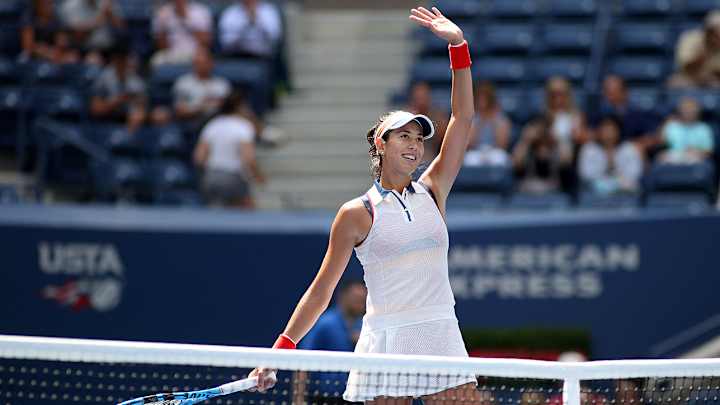Five Thoughts on U.S. Open Day 1: Muguruza Sends Message, Murray's Post-Draw Withdrawal

NEW YORK – Five thoughts from the first day of the last Slam…
• With Serena Williams assuming the status of expectant mother, Spain's Garbine Muguruza has assumed the status as the favorite to win the women’s title. This would mean backing up her Wimbledon triumph and—more relevant—continuing the hardcourt prowess she showed off earlier this month in Cincinnati. Muguruza has four career titles and two of them are Slams, the encapsulation of an up-and-down career. Sometimes she’s Mugu-ruthless. Other times Mugu-rueful. At the U.S. Open, she’s never been past the second round. On Monday, she kicked off the tournament with a dazzling performance, beating Varvara Lepchenko, the American veteran, 6-0, 6-3 in roughly the time it takes to read this item. Intentional or not, Muguruza fired off a message to the field today.
U.S. Open 2017 Tennis Live Updates: Pliskova, del Potro Advance; Fognini Suspended
• On days like this, it’s scarcely possible to keep up with the onslaught of results. (I write this before Venus has finished; but after Isner has won.) But just seeing the names and country codes flit across various screens, you’re reminded of the richness of the sport. One player recovered from a diabetic coma and qualified, despite playing No. 5 singles on his college team. Another is the daughter of a former NFL player suffering from CTE. A third lacked indoor plumbing. A 32-year-old Israeli beat a 21-year-old African American who plays for Georgia Tech, while a recent stabbing victim beat a former No. 1. One of the great cardinal rules of journalism: everyone comes from somewhere; everyone has a story to tell. No more so than in this sport.
• The remains much chatter about Andy Murray’s “post-draw withdraw,” his Saturday decision to exit the event, a day after the pairings were official. In Murray’s stead, the fifth seed, Marin Cilic moved into the No. 2 spot—and won his opening match on Monday in four sets over the spectacularly named TennysSandgren.
The knee-jerk reaction to enact a “re-draw” is natural. Why not place the top two remaining players on opposite halves? That we’re talking about Federer and Nadal—winners of the last three majors; classic rivals; two players who have clashed nearly 40 times but never here in New York—only fueled the desire. But, practically speaking, it’s impossible. Players saw their pairings Friday and reacted accordingly. Drew a lefty? You practiced against a lefty. Landed on the top half? You began hydrating and scheduling in anticipation of a Monday start. Conducting the entire draw afresh? It would’ve simply inconvenienced too many players.
Murray has come under fire for waiting so long to reach his conclusion. But this tells me he simply wanted to wait as long as possibly before making the unfortunate decision. The USTA has come under fire. But rules are rules; and they were followed in this case. Overall, I think we just chalk this up to an unfortunate set of events. And break with objectivity and hope to heck Federer and Nadal meet in the semis.
Andy Murray Withdraws From U.S. Open
• In keeping with Slam tradition, on Monday, we saw players who were clearly physically compromised, take the court anyway, harboring no intention of winning but every intention of pocketing the $50,000 conferred on first round losers. Naming and shaming, Dmitry Tursunov was an early perpetrator, pulling the proverbial ripcord down 6-7, 1-6 to Cameron Norrie, the former college standout. It's hard to be too critical. This is an expensive career and eligible players have earned the right to this $50,000 payday. But it deprives the fans of a competitive match and deprives able-bodied colleagues of a spot.
The solution: pay all eligible players the first round money. But those are in no physical shape to compete, can surrender their spot to a lucky loser. Those lucky losers—playing with house money—only get paid if they win. Thus, the eligible players get their money. Other players get an opportunity. Tournaments don’t have an incremental spend. And the fans get competitive matches. Someone make that happen….
• Most years, the U.S. Open kicks off with a Monday night extravaganza. Celebrities ring the court. A musical act performs for the crowd. (Lenny Kravitz and Phil Collins have been summoned in recent years.) A star—Federer, Nadal, Serena—takes the court and shows off their chops, in less a performance than a competition, making tartare out of a hapless opponent. Overall, it's a celebration of tennis and its virtues.
This year? Not so much. There will be the Grand Opening. In the absence of Milos Raonic, Shania Twain will represent Canada as the headliner. And then we will segue awkwardly to…. a fierce and textured competition that will yield an exultant winner and embittered loser.
Shania Twain To Kick Off 2017 U.S. Open
Under other circumstances, Maria Sharapova versus Simona Halep could be a Grand Slam final. In fact, at the 2014 French Open it WAS a Grand Slam final. Tonight it’s a first round match. By now you likely know the context. Sharapova was, controversially, given a wildcard as she attempts to regain some measure of control over game, addled by a doping suspension and then injury. Halep attempts, yet again, to finish a tournament with the top ranking. Halep is 0-6 against Sharapova. Then again, Sharapova has played nine matches in 18 months. It's a brutal encounter for both players. It’s delicious for fans, especially on Opening Night.
